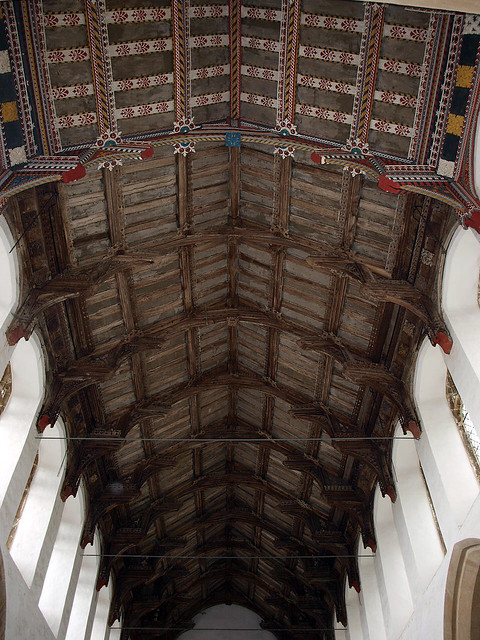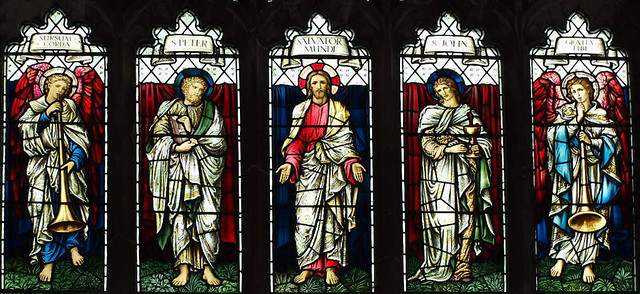ST MARY. Dec W tower. The bell-openings have Y-tracery and also flowing tracery, which is unusual for towers. Early C16 stair-turret of brick. S aisle and S porch Perp. Inscription on the S aisle commemorating Robert Goche and his wife, and James Hobart, his wife, and his parents. Cautley points out that Sir James Hobart was Attorney-General under Henry VII. N aisle also Perp. Clerestory with doubled windows. The arches with intermittent radially placed bricks. The windows are of two lights with panel tracery. A variety of flushwork emblems between them. The arcade is of five bays and has octagonal piers and double-chamfered arches. Nave roof with double hammerbeams, the figures sawn ofi‘. Big square flowers on the wall-plates. Fine cresting on the purlins. Colouring over the rood-bays. The aisle roofs also have decorated wall-plates. The chancel roof is cambered and has arched braces. The E bays have coloured stylized symmetrical leaves or palmettes. The roofs were restored in 1860 and 1864 by Butterfield. - FONT. Octagonal. Against the stem two tiers of shields and square flowers. Against the bowl angels with shields, a shield, and square flowers. - BENCHES. Two, with carved backs, poppy-heads, and on the arms three animals and one kneeling figure.- SCREEN. With one-light divisions, ogee arches, and close panel tracery above them. Two parts under the tower arch. - WALL PAINTING. Dim Doom over the chancel arch. - STAINED GLASS. E window c. 1920 by Morris & Co., partly still to the design of Burne-Jones. - PLATE. Elizabethan Cup; Paten 1682; Almsdish 1729; Flagon 1756. 3 MONUMENTS. In the nave good tablets with cartouches: George Pretyman d. 1732; his widow d.1738.
BACTON. A stream runs down its street and we cross it by a bridge to enter the churchyard, with a church from the 14th and 15th centuries. The windows of the clerestory have under them flint panels of various designs forming a fine line of decoration.
The greatest treasure here is the magnificent double hammerbeam roof. Part of it is brilliantly coloured, and row after row of carving rises one above another to the ridge, while the great bosses have many exquisite designs. The elaborate richness of the roof is so insistent that it draws and holds our gaze. But there are other fine things to see: the elegant pillars of the arcade, and the dainty Tudor roses on the 15th century screen and on the font. The staircase turret is lighted by quatrefoils and there are two shields of old glass in a chancel window. Some of the poppyhead benches have carvings of birds and beasts, and two back benches have many carved designs.
There are still on the wall here traces of the remains of what must have been a painting, full of vigour and detail, of the Last Judgment. In the lower part the dead are seen rising from their tombs, and odd bits of colour here and there stand out from the blank wall. One vicar, Edward Burton Barker, was here for more than half of last century, all through Trafalgar and Waterloo and the Crimean War. In the five-light west window, set up as a peace memorial, are angels with trumpets, Our Lord, St Peter, St John, and the Evangelists.



No comments:
Post a Comment